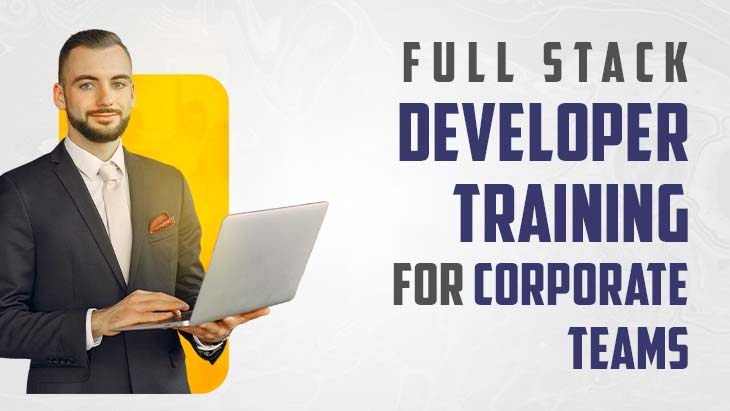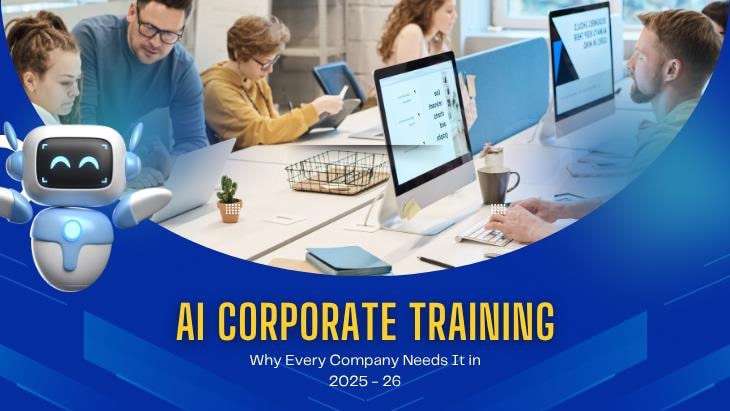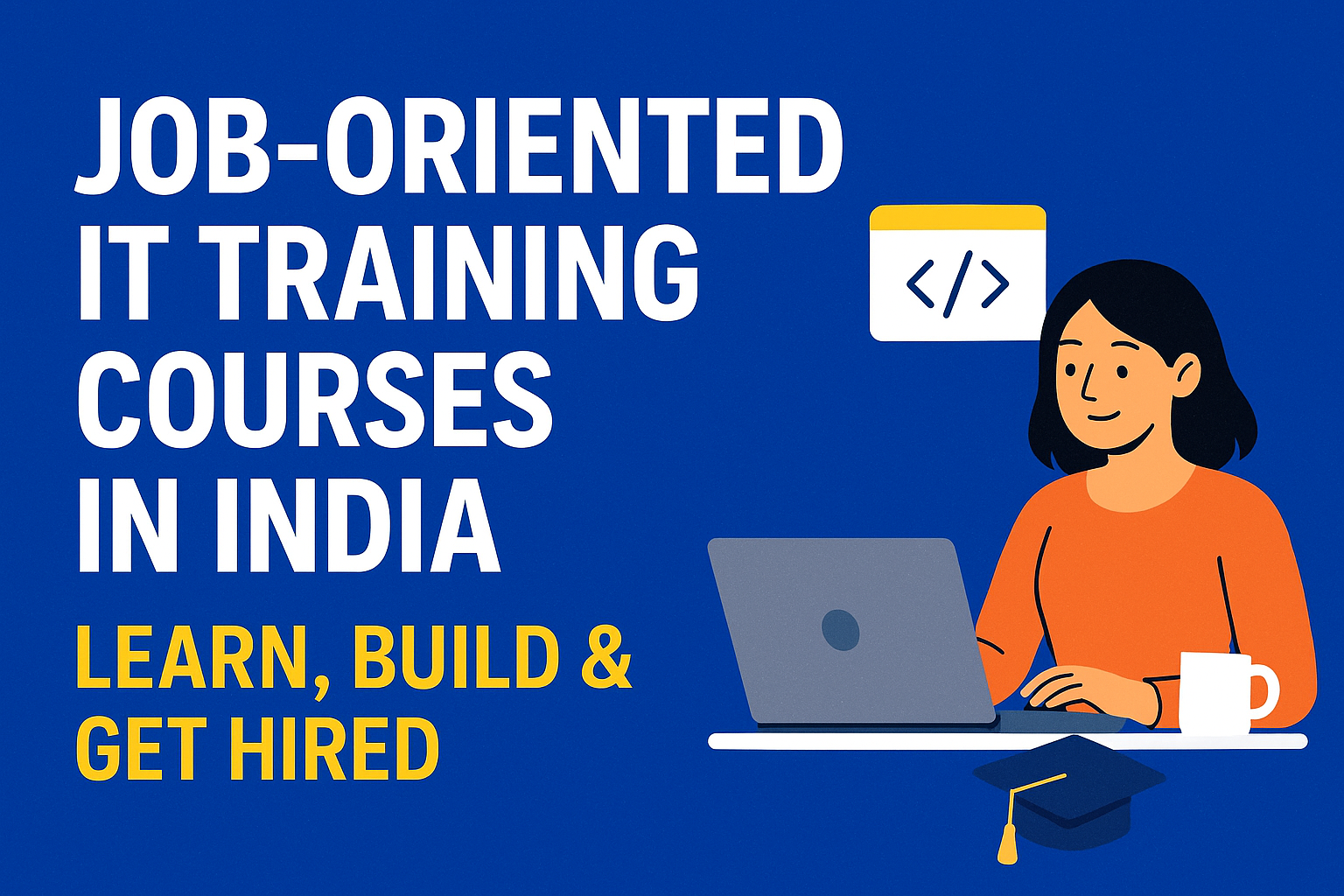In today’s tech-driven market, legacy systems and skills gaps slow delivery and inflate costs. Whether you’re automating operations, building customer apps, or modernising internal tools, you need people who can think and execute like developers.
That’s where full stack developer training for corporate teams pays off. It’s not just “teaching code”—it builds end‑to‑end problem solvers who can work across frontend and backend, ship faster, and collaborate better.
This guide explains what corporate full stack training includes, who it’s for, how it’s delivered, and the outcomes you can expect.
What Does "Full Stack" Mean?
Full stack covers the technologies used to deliver a complete app—from the user interface to the server and database behind it.
- Frontend (client‑side): Interfaces users see and use. HTML, CSS, JavaScript, and frameworks like React, Angular, or Vue.
- Backend (server‑side): Business logic, APIs, and integrations. Common stacks include Node.js/Express, Python (Django/Flask/FastAPI), Java (Spring Boot), or .NET.
- Data layer: Relational (PostgreSQL, MySQL) and NoSQL (MongoDB, Redis); data modelling, indexing, and performance.
- Version control, CI/CD, and deployment: Git/GitHub, branching/PRs, Docker, pipelines, and cloud (AWS/Azure/GCP).
Who should attend and prerequisites
Ideal participants
- Frontend or backend developers upskilling to full stack
- QA/SDET engineers transitioning into development
- Tech leads, solution architects, and product/engineering managers seeking hands‑on depth
Prerequisites
- Comfort with at least one programming language
- Basic Git/CLI and core HTML/CSS concepts
- 6–8 hours/week available for hands‑on coding during the program
Why Corporates Are Investing in Full Stack Developer Training
Companies used to have separate teams for frontend and backend development. But professionals who can work in both worlds are needed for projects that move quickly these days. Because of this change, full stack developers are now some of the most in-demand workers in the IT field.
More and more companies are using corporate full stack training programs for these reasons:
- Faster Project Execution: Employees who are trained in full stack can work on all parts of the development cycle without needing help from many different specialists. This makes communication easier, speeds up timelines, and makes development more flexible.
- Cost-Effective Resource Utilization: It can be expensive to hire or outsource for every tech job. By giving your current employees more skills, you can save time and money by allowing teams to do more work on their own.
- Better teamwork Collaboration: When everyone knows how both sides of development work, it is easier for developers, designers, testers, and managers to talk to each other and get things done.
- Future-Proof Workforce: Technology stacks are always changing. Teaching employees to think like full stack developers gives them flexible problem-solving skills that will always be useful, even when new tools come out.
- Creativity and Freedom: Employees who have power don't just do their jobs; they come up with new ideas. They can come up with and prototype new ideas on their own if they know how to work with the whole stack. This is a huge benefit for companies that want to be innovative.
What You Will Learn in Full Stack Developer Training
Frontend development essentials
- HTML5, CSS3, modern JavaScript (ES6+), TypeScript fundamentals
- React/Angular/Vue: components, state, routing, accessibility
- API integration, performance (Lighthouse), component and e2e testing
Backend development and APIs
- Node.js/Express or Python (Django/FastAPI) or Java (Spring Boot)
- REST vs GraphQL: when and why
- Authentication/authorisation (JWT/OAuth2), input validation, rate limiting
- Error handling, logging, and middleware patterns
Databases and data handling
- Schema design, normalisation, and indexing (PostgreSQL/MySQL)
- NoSQL patterns with MongoDB/Redis; when to choose which
- Query design, transactions, and ORMs (Prisma/TypeORM/Sequelize)
Version control, CI/CD, and collaboration
- Git flows: branching, reviews, PR quality checks
- CI/CD pipelines (GitHub Actions/GitLab CI/Azure DevOps)
- Environments, feature flags, and release strategies
Cloud deployment and DevOps awareness
- Containers with Docker; 12‑factor app basics
- Deploying to AWS/Azure/GCP; IaC overview (Terraform basics)
- Scalability, cost awareness, and environment configuration
Security by design (corporate must‑have)
- OWASP Top 10; secure API design; CORS/CSRF
- OAuth2/JWT, RBAC/ABAC, secrets management (vaults, KMS)
- Data protection, logs hygiene, and least privilege in cloud
Quality engineering and testing culture
- Unit/integration/e2e testing (Jest/Mocha/Cypress/PyTest)
- Code style, lint/format, and review standards
- CI quality gates, coverage targets, and static analysis
Architecture and observability
- Monolith vs microservices; MVC vs hexagonal/clean architecture
- Caching (Redis), queues/events (e.g., SQS/RabbitMQ), API documentation (OpenAPI/Swagger)
- Observability: structured logging, metrics, tracing; dashboards (ELK/Grafana/CloudWatch)
Agile workflows that stick
- Scrum/Kanban in practice; story slicing and estimation
- Jira/Trello workflows; definition of ready/done
- Peer programming, code reviews, and feedback cycles
Real‑world project delivery (capstone)
Design, build, test, and deploy a full application end‑to‑end
Example capstones:
- Internal CRM or employee portal (RBAC + audit logs)
- Ops dashboard with ETL + caching + role‑based reporting
- Self‑service request/approval portal with notifications
- Stakeholder demo and code review against a rubric
Sample 8–10 week plan (customisable)
- Week 1: Modern JS/TS; Git/GitHub flow; code quality tools
- Week 2: Frontend framework (React/Angular) and accessibility
- Week 3: API integration; UI performance; component/e2e testing
- Week 4: Backend (Node.js/Express or Python/FastAPI); routing/services
- Week 5: Data layer (PostgreSQL/MySQL + ORM); schema/indexes
- Week 6: Auth, security, and secure API design
- Week 7: CI/CD pipelines; Docker; environment strategy
- Week 8: Cloud deploy (AWS/Azure/GCP); observability
- Weeks 9–10: Capstone build + demo; code reviews and retros
Assessment, certification, and post‑training support
Assessment
- Graded capstone with rubric (architecture, code quality, tests, security)
- Peer programming, code reviews, and short quizzes
- Stakeholder demo with feedback
- Certification
-
TechaEDU Full Stack Practitioner (MERN/MEAN/Java/.NET) digital badg
-
Post‑training support
- Office hours and code clinics for 60/90 days
- Slack/Teams channel for Q&A and code reviews
- Optional on‑project mentoring for the first production build
How Corporate Full Stack Training Is Delivered
There isn't a single way to do corporate training. The size of the organization, the structure of the team, and the level of technical maturity all affect how programs are designed. Some common ways to train are:
- Instructor-led workshops, whether online or in person, are great for learning together with guidance.
- Self-Paced Learning Paths: For workers who like to have options.
- Models of blended learning: live sessions and project-based tests are used together.
- Customized Corporate Bootcamps: Short, intense sessions that focus on certain stacks, like MEAN or MERN.
For example, TechaEDU focuses on hands-on mentoring and modular learning, which lets businesses train teams without interrupting their regular work.
Key Outcomes of Full Stack Developer Training for Corporates
When your team finishes a well-organized program, the benefits go beyond just learning new technical skills. Companies usually go through this:
- Enhanced Productivity: Teams that know how to develop from start to finish don't have to go back and forth as much, which speeds up projects and cuts down on delays.
- Flexibility across departments: Employees can take on different roles as needed, from design to deployment, which makes the team more flexible.
- Higher Employee Retention: Giving employees chances to grow in their careers shows that the company cares about their growth. This makes people more motivated and loyal.
- Better quality code: Training includes the best ways to test, debug, and write clean code, which makes applications more reliable and easier to maintain.
- Stronger Innovation Culture: When workers know they can build and try new things, innovation becomes a natural part of your company's DNA.
Why Choose TechaEDU for Corporate Full Stack Training
- Practical, project‑based learning that mirrors your environment
- Industry‑experienced trainers who’ve shipped at scale
- Customisable modules aligned with your tech stack and KPIs
- Assessments, certification, and post‑training support for retention
How TechaEDU partners with enterprises
- Discovery and skills gap analysis
- Custom syllabus and roadmap
- Pilot cohort with defined outcomes
- Scale across teams and roles
- Measure impact (Kirkpatrick L1–L3 + delivery KPIs)
- Iterate with stakeholder feedback
In Conclusion
Technology changes quickly, and businesses that don't invest in training their employees risk falling behind. Full Stack Developer training gives business teams more control over their digital projects, helps them come up with new ideas faster, and lets them work more independently.
Not only are you filling in technical gaps by training your employees to think about the whole development lifecycle, you're also making your company ready for the future.





Leave a reply